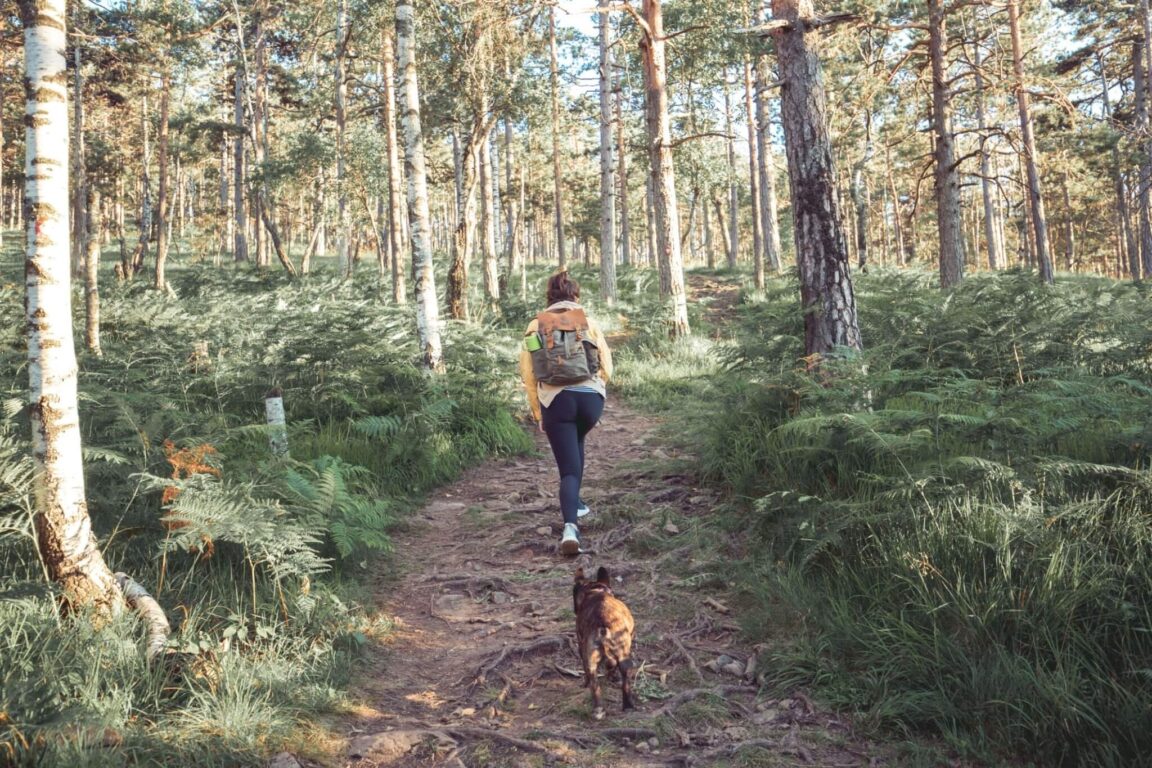Do you want to go on a backcountry adventure with your best four-legged friend? Not only will your dog explore, smell, and see a new part of the world, but they’ll also get to do so with their best friend (you!) by their side.
Of course, just as humans must prepare for a hike, so must dogs. And because they’re, well, dogs, it’s up to their owners to keep them safe and healthy on the trails. From gears to Leave No Trace principles, here’s what you need to know when planning a hike with your dog. Before you leave, consult with your veterinarian, as they may have additional recommendations based on your dog’s health or environment.
Preparation and Planning
Fortunately, with proper preparation and planning, both humans and dogs can enjoy the great outdoors, whether on a multi-day trip or a short hike through a state park.
Selecting the Best Route
As with human hikers, it’s essential to begin with easy trails and work your way up to steeper and longer hikes so you know what your dog can handle and their fitness level. Smaller or older dogs may be unable to walk for more than a mile, whereas younger, energetic dogs should have no trouble joining you as you rack up the miles. To begin, judge your dog conservatively unless you want to end up carrying them back to the trailhead.
You must also ensure that the trail you choose allows dogs (pro tip: most trails in national parks do not), and you must be aware of the trail’s leash laws. Many urban parks and areas require dogs to be on leashes, whereas courses in more remote regions frequently require your dog to be under voice control; expect mostly off-leash pups on these types of trails.
Baseline Health and Training
Whether your dog has a leash on or will stroll alongside you, make sure they understand a few commands: stay, come, and “leave it.” This is important if your dog tends to “follow his nose.” Certain things that smell good to a dog, such as bear poop, trash, or dead animals, can make them sick. Practice these skills with your dog outside the house to ensure that your pup responds even when distracted or overly excited.
Unlike human hiking partners, who are often too quick to tell you when they’re exhausted, your dog will not complain if they’re overexerting themselves or pulling a muscle—which is why knowing your dog’s baseline health is critical. Are they frequently panting? How fast does their heartbeat usually beat? Is your dog friendly with other people, or are they more reserved? Knowing your pet’s baseline health statistics can help you notice injuries faster and assess the extent of the damage on the trail. You can make an appointment with your veterinarian at the start of the hiking season to better understand your pet’s daily health.
Vaccinations and medications
Your dog may require additional vaccinations or medications before embarking on a hiking trip, depending on where you live. If you’re hiking in the desert, bring a rattlesnake antidote for your dog, and ask your vet about a leptospirosis vaccine, and Fido is likely to come across standing water. Remember that your dog, like you, is susceptible to bug bites, sunburn, and allergic reactions. Here’s a handy list of medications most dogs can and cannot take. The American Red Cross also offers dog first-aid classes in person and online.

On the Roads
Are you sure your pet is ready for the trail? Here’s what you should bring with you before you leave.
Food and Beverage
Your dog, like you, is expending energy on the trails. Your dog eats twice a day; you should bring a snack for them to keep their energy levels up (a handful of their regular kibble will likely do just fine). You should also bring extra water. Because dogs do not sweat, panting usually indicates that your dog is dehydrated.
Allow your dog to drink from a natural water source only if you would drink from it yourself. While dogs’ stomachs can generally withstand more than human stomachs, water-borne diseases are common, so it’s best to be cautious. You should have a bowl or container for your dog to drink from, and you should always overestimate how much water you require.
Hiking in a harness is far more comfortable for most dogs than hiking with a leash clipped to their collar. To avoid overheating and chafing, choose a harness with adequate padding and breathability. Large and active dogs may be able to wear a harness with attached saddlebags to carry snacks, dog-safe sunscreen, or whatever else they require.
Many hikers believe that carrying a backup leash is a good idea, especially if you’ll be at a trailhead with heavy vehicle traffic. Your dog may require booties or a sweater depending on the terrain and weather. Make sure your first-aid kit contains medication and supplies that are appropriate for both you and your dog. If you’re driving your dog to the trailhead, use a harness and a doggy seat belt to keep him safe.
Trail Manners for Dogs
While most hikers enjoy seeing dogs on the trails, it is still essential to consider your surroundings and other hikers. This is how.
Wildlife
It may be fascinating to let your dog run wild; make sure you can always keep an eye on them. Dogs can scare wildlife, separate woodland parents from their newborns, and disrupt animals’ natural behaviors. You would not allow a human to destroy a groundhog’s burrow, so do not allow your dog to do so.

Make No Trace
When hiking, humans should always practice Leave No Trace principles, which means picking up your dog’s waste on the trails. Carry biodegradable poop bags and dispose of them in the same manner as you would trash and plastic. Keep food away from wildlife as part of Leave No Trace, so they don’t associate humans with food. When camping, keep your dog’s food out of reach of wildlife (a bear bin may be required in more remote areas), and don’t leave kibble behind after your pup’s mid-day snack.
Hiking Companions
Even on off-leash trails, your dog must be under your voice command in case you come across other hikers who dislike dogs, wildlife, or dogs who aren’t as friendly as yours. Before allowing your off-leash dog to say “hello,” make sure he knows how to approach people and other dogs calmly and ask owners if their dogs are friendly.
Dog owners understand that their pet’s personality, likes, and preferences are as diverse as humans’, so remember that your specific dog may require accommodations in addition to those listed here. And don’t forget that every dog, regardless of age or breed, enjoys a good nap after a hike. Allow time for your pup to recover (and plenty of positive reinforcement) before heading out on the trails for another day of exploration.




GIPHY App Key not set. Please check settings
2 Comments